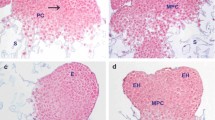Abstract
Previously we showed that dormancy break of spindle tree embryos after gibberellic acid (GA3) treatment was followed by an increase in arginine decarboxylase (ADC) activity (Béranger-Novat N. et al., Plant Sc. 102: 139–145, 1994). These results indicated that arginine decarboxylase pathway mediate hormone-induced growth responses in spindle tree embryos. In the present investigation we show that in GA3-treated embryos diamine oxidase (DAO) increases immediately after putrescine content and the increase in DAO activity paralleles the accumulation of putrescine at the beginning of the culture (before the visible appearance of the radicle). In this system polyamine oxidase (PAO) increases immediately after DAO activity and follows closely the increase in spermidine content. These results demonstrate a direct correlation between the biosynthesis and oxidation of putrescine and spermidine. At every stage of development DAO and putrescine levels are lower than spermidine and PAO levels. Dormant embryos can be distinguished from GA3-treated embryos by a complete lack of putrescine accumulation. In dormant embryos compared to GA3-treated embryos DAO changed more or less in parallel and on the whole seemed to follow the same content and distribution, but the kinetics of the activation of DAOs were different in dormant embryos with a delay of 1.5 day for the first and 1 day for the second peak. During the first days of culture at least up to 4 days the distribution of spermidine and PAO in GA3-treated embryos followed the same pattern observed in dormant embryos, but the levels of spermidine and PAO were greatly reduced in dormant embryos. On the other hand the kinetics of the activation of PAOs were different in dormant embryos with a delay of 1 day. The results suggest that dormant embryos are deficient in their ability to synthesize polyamines efficiently and support the view that spermidine catabolism (via PAO pool) is limiting in untreated embryos during the first days of culture.
Similar content being viewed by others
References
Aribaud M, Carré M and Martin-Tanguy J (1994) Polyamine metabolism and in vitro cell multiplication and differentiation of leaf explants of Chrysanthemum morifolium Ramat. cultivated in vitro. Plant Growth Regul 15: 143–155
Bagni N, Torrigiani P and Barbieri P (1981) Effect of various inhibitors of polyamine synthesis on the growth of Helianthus tuberosus. Med Bio 5: 403–409
Beranger-Novat N and Davidowics-Grzegarzewska (1992) Effect of gibberellin on mature Euonymus europaeus L. seeds. Ann Bot 70: 93–100
Beranger-Novat N, Monin J and Martin-Tanguy J (1994) Polyamines and their biosynthetic enzymes in dormant embryos of the spindle tree (Euonymus europaeus L.) and in dormancy break obtained after treatment with gibberellic acid. Plant Sci 102: 139–145
Beranger-Novat N, Monin J and Singh CP (1977) Essai de définition des états physiologiques les plus favorables à l'action d'un traitement gibberellinique de levée de dormance chez l'embryon d'Euonymus europaeus. C R Soc Biol 171: 82–86
Bonneau L, Carré M and Martin-Tanguy J (1994) Polyamines and related enzymes in rice seeds differing in germination potential. Plant Growth Regul 15: 75–82
Bonneau L, Carré M and Martin-Tanguy J (1994) Polyamine metabolism during seedling development in rice. Plant Growth Regul 15: 83–92
Bradford MM (1976) A rapid and sensitive method for the quantification of microgram quantities of protein utilizing the principle of protein dye binding. Ann Biochem 72: 248–25
Davies PJ (ed) (1989) Plant Hormones and Their Role in Plant Growth and Development. Martinus Nijhoff Publisher
Frederico R and Angeliono R (1991) Polyamine catabolism in plant. In: Slocum RD and Flores HE (eds) Biochemistry and Physiology of Polyamines in Plants, pp 41–53. Florida, USA: CRC Press
Gautheret RJ (1959) La culture des tissus végétaux: techniques et réalisations. Masson, pp. 863
Malinski C, Bieganski T, Fogel WA and Kitler ME (1965) Diamine oxydase in developing tissues. In: Mondovi B (ed) Structure and Reactions of Polyamine Oxidases, pp 154–166. Florida, USA: CRC Press
Perin A, Sessa A and Desiderio MA (1985) Diamine oxidase in regenerating and hypertrophic tissues. In: Mondovi B (ed) Structure and Reactions of Polyamine Oxidases, pp 179–186. Florida, USA: CRC Press
Rastogi R and Davies PJ (1991) Effects of light and plant growth regulators on polyamine metabolism in higher plants, In: Slocum RD and Flores HE (eds) Biochemistry and Physiology of Polyamines in Plants, pp 187–198. Florida, USA: CRC Press
Rinaldi A, Floris G and Giartosio A (1986) In: Mondovi B (ed) Plant Amine Oxidase, pp 51–71. Florida, USA: CRC Press
Serafini-Fracassini D (1991) Cell cycle dependent changes in plant polyamine metabolism. In: Slocum RD and Flores HE (eds) Biochemistry and Physiology of Polyamines in Plants, pp 159–173. Florida, USA: CRC Press
Sessa A, Desiderio MA and Perin A (1982) Diamine oxidase activities induction in regenerating rat liver. Biochem Biophys Acta 698: 11–14
Slocum RD, Kaur-Sawhney R and Galston A (1984) The Physiology and Biochemistry of Polyamines. Arch Biochem Biophys 235: 283–288
Smith TA (1980) Plant Amines. In: Ben EA and Charlwood BU (eds) Encyclopedia of Plant Physiology, Vol. 8, pp 433–460. Berlin: Springer Verlag
Smith TA (1985) Di and polyamine oxidases of higher plants. Biochem Soc Trans 13: 319–322
Smith MA (1990) The involvement of polyamines in the genetic and gibberellic acid control of internodal growth in peas. In: Flores HE, Arteca RN and Shannon JC (eds) Polyamines and Ethylene, Biochemistry, Physiology and Interactions, pp 101–111. Pennstate: American Society of Plant Physiologists
Tiburcio AF, Kaur-Sawhney R and Galston AW (1990) Polyamine metabolism. In: The Biochemistry of Plants, 16, pp. 283–325. Academic Press
Torrigiani P, Serafini-Fracassini D and Fara A (1988) Diamine oxydase activity in different physiological stages of Helianthus tuberosus tuber. Plant Physiol 89: 69–73
Author information
Authors and Affiliations
Rights and permissions
About this article
Cite this article
Béranger-Novat, N., Monin, J., Jassey, J. et al. Polyamine catabolism in dormant embryos of the spindle tree (Euonymus europaeus L.) and in dormancy break obtained after treatment with gibberellic acid. Plant Growth Regulation 21, 65–70 (1997). https://doi.org/10.1023/A:1005728313877
Issue Date:
DOI: https://doi.org/10.1023/A:1005728313877




